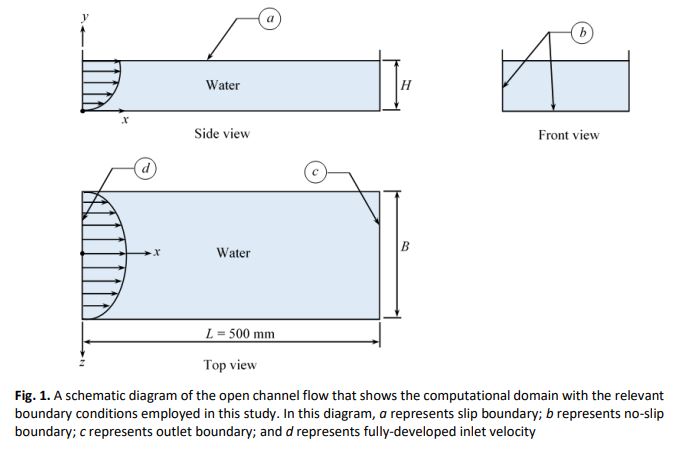Secondary Currents at Very Low and High Aspect Ratios of Open Channels
DOI:
https://doi.org/10.37934/cfdl.14.5.115Keywords:
Secondary currents, turbulence, CFD, IDDES modelAbstract
The present numerical study is an attempt to better understand the effect of the aspect ratio (AR) on the velocity field characteristics of the fully-developed turbulent flow in a straight open channel by contrasting a very low and very high aspect ratio cases (AR = 1 and 12). The AR is defined as the ratio of the width of the channel in a plane normal to the flow direction, to the flow depth. The bulk velocity and water depth considered in this study are 0.75 m/s and 30 mm, respectively, which yield a Reynolds number of ReH = 22,500. The transient three-dimensional Navier-Stokes equations were numerically solved using a finite-volume approach with improved-delayed detached-eddy simulation (IDDES) turbulence model. The results revealed that the normalized components of the normal stresses by the turbulent kinetic energy k are constant over most of the velocity field, although k varies in magnitude throughout the velocity field in both AR cases. In addition, the results also revealed a strong anisotropic flow which justifies the formation of secondary currents as a means for transporting the kinetic energy. The results also reveal that both vertical and transverse components of the normal stresses are correlated to the side-recirculation zone (SRZ) and bottom-recirculation zone (BRZ), respectively, which highlights the role of the mean recirculation zones (BRZ & SRZ) in the re-distribution of the turbulent kinetic energy k in the velocity field.
Downloads
References
Bradshaw, Peter. "Turbulent secondary flows." Annual review of fluid mechanics 19, no. 1 (1987): 53-74. https://doi.org/10.1146/annurev.fl.19.010187.000413
Einstein, Hans Albert, and Huon Li. "Secondary currents in straight channels." Eos, Transactions American Geophysical Union 39, no. 6 (1958): 1085-1088. https://doi.org/10.1029/TR039i006p01085
Nezu, Iehisa. "Experimental study on secondary currents in open channel flows." In Proc. of 21st IAHR Congress, Melbourne, 1985, vol. 2, pp. 115-119. 1985.
Nezu, I., H. Nakagawa, and A. Tominaga. "Secondary currents in a straight channel flow and the relation to its aspect ratio." In Turbulent shear flows 4, pp. 246-260. Springer, Berlin, Heidelberg, 1985. https://doi.org/10.1007/978-3-642-69996-2_20
Shinneeb, A-M., G. Nasif, and R. Balachandar. "Effect of the aspect ratio on the velocity field of a straight open-channel flow." Physics of Fluids 33, no. 8 (2021): 085110. https://doi.org/10.1063/5.0057343
Nezu, Iehisa, and Hiroji Nakagawa. Turbulence in open-channel flows. Routledge, 2017. https://doi.org/10.1201/9780203734902
Tominaga, Akihiro, Iehisa Nezu, Kazuhiro Ezaki, and Hiroji Nakagawa. "Three-dimensional turbulent structure in straight open channel flows." Journal of hydraulic research 27, no. 1 (1989): 149-173. https://doi.org/10.1080/00221688909499249
Nasif, G., R. Balachandar, and R. M. Barron. "Supercritical flow characteristics in smooth open channels with different aspect ratios." Physics of Fluids 32, no. 10 (2020): 105102. https://doi.org/10.1063/5.0021609
Siemens PLM-Global, STAR-CCM+ V13.06.012, User Manual, 2018.
Versteeg, H. K., and W. Malalasekera. "An introdution to computational fluid dynamics." The finite volume method (1995).
Menter, F. R., and M. Kuntz. "Adaptation of eddy-viscosity turbulence models to unsteady separated flow behind vehicles." In The aerodynamics of heavy vehicles: trucks, buses, and trains, pp. 339-352. Springer, Berlin, Heidelberg, 2004. https://doi.org/10.1007/978-3-540-44419-0_30
Travin, Andrey, Michael Shur, Michael Strelets, and P. R. Spalart. "Physical and numerical upgrades in the detached-eddy simulation of complex turbulent flows." In Advances in LES of complex flows, pp. 239-254. Springer, Dordrecht, 2002. https://doi.org/10.1007/0-306-48383-1_16
Spalart, Philippe R., Shur Deck, Michael L. Shur, Kyle D. Squires, M. Kh Strelets, and Andrei Travin. "A new version of detached-eddy simulation, resistant to ambiguous grid densities." Theoretical and computational fluid dynamics 20, no. 3 (2006): 181-195. https://doi.org/10.1007/s00162-006-0015-0
Wilcox, David C. "Simulation of transition with a two-equation turbulence model." AIAA journal 32, no. 2 (1994): 247-255. https://doi.org/10.2514/3.59994
Wilcox, David C. "Turbulence modeling for CFD. La Canada, CA: DCW Industries." Inc, November (2006).
Nasif, G., R. Balachandar, and R. M. Barron. "Influence of bed proximity on the three-dimensional characteristics of the wake of a sharp-edged bluff body." Physics of Fluids 31, no. 2 (2019): 025116.
https://doi.org/10.1063/1.5085666
Nasif, G., R. Balachandar, and R. M. Barron. "Effect of gap on the flow characteristics in the wake of a bluff body near a wall." International Journal of Computational Methods and Experimental Measurements 7, no. 4 (2019): 305-315.
https://doi.org/10.2495/CMEM-V7-N4-305-315
Nasif, Ghassan, A-M. Shinneeb, Ram Balachandar, and Chandra Somayaji. "Turbulent Structures in Gap Flow." CFD Letters 14, no. 2 (2022): 24-34.
https://doi.org/10.37934/cfdl.14.2.2434
Nasif, Ghassan Gus. "CFD Simulation of Oil Jets with Application to Piston Cooling." (2014).
Heidari, Mehdi, Ram Balachandar, Vesselina Roussinova, and Ronald M. Barron. "Characteristics of flow past a slender, emergent cylinder in shallow open channels." Physics of Fluids 29, no. 6 (2017): 065111. https://doi.org/10.1063/1.4986563
Spalart, Philippe R., and Craig Streett. Young-person's guide to detached-eddy simulation grids. No. NAS 1.26: 211032. 2001.
Shinneeb, Monsif, Ghassan Nasif, And Ram Balachandar. "Computational Investigation of the Effect of the Aspect Ratio On Secondary Currents in Open Channels." Advances in Fluid Dynamics with emphasis on Multiphase and Complex Flow 132 (2021): 49.
https://doi.org/10.2495/MPF210051
Clauser, Francis H. "Turbulent boundary layers in adverse pressure gradients." Journal of the Aeronautical Sciences 21, no. 2 (1954): 91-108.




























